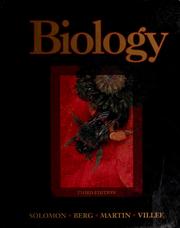| Listing 1 - 10 of 77 | << page >> |
Sort by
|
Book
ISBN: 2257102363 9782257102362 Year: 1976 Publisher: Paris: Flammarion,
Abstract | Keywords | Export | Availability | Bookmark
 Loading...
Loading...Choose an application
- Reference Manager
- EndNote
- RefWorks (Direct export to RefWorks)
Immunology. Immunopathology --- Immunology --- Immunobiology --- Life sciences --- Serology
Book

ISBN: 2348075652 9782348075650 Year: 2022 Publisher: [Paris] Muséum national d'histoire naturelle : La Découverte
Abstract | Keywords | Export | Availability | Bookmark
 Loading...
Loading...Choose an application
- Reference Manager
- EndNote
- RefWorks (Direct export to RefWorks)
La Terre s'est formée il y a 4,5 milliards d'années mais nous ne le savons que depuis la seconde partie du XXe siècle. Alors que nous recensions quelques milliers d'espèces au milieu du XVIIIe siècle, on en identifie aujourd'hui deux millions, et l'on estime que ce nombre ne représente que 20 % de la richesse totale encore à décrire ! Quant à l'humain, si l'on pensait que son histoire se résumait à une succession de deux ou trois espèces sur deux millions d'années, on découvre aujourd'hui que dix fois plus d'espèces d'hominines ont existé, sur sept millions d'années. Chaque découverte augmente le niveau de complexité de ce que l'on sait et élargit le périmètre de ce qu'il reste à connaître. La vitalité de la recherche bénéficie de multiples évolutions techniques, méthodologiques et conceptuelles. Si l'histoire naturelle favorise depuis toujours les approches interdisciplinaires, quelques-unes - comme la cosmochimie, l'archéozoologie ou encore la paléogénétique - ont connu un grand élan ces dernières décennies. Le perfectionnement des outils de mesure, de l'imagerie scientifique ou des instruments de séquençage génétique donne un nouveau souffle à des études engagées de longue date. Enfin, de nouvelles façons de faire et de penser émergent, comme en témoignent l'essor des sciences participatives et l'apparition de nouveaux concepts (holobionte, anthropocène, One Health, etc.). Voici un aperçu des foisonnants travaux menés au Muséum national d'histoire naturelle, qui remettent en cause la façon dont chacun d'entre nous se situe dans l'univers, dans la nature, dans la société. Des premiers indices de vies aux biofilms des caniveaux urbains, les contributions ici réunies relatent d'étonnantes petites et grandes découvertes. Entre miscellanées et synthèse, cet ouvrage donne à voir la diversité d'un patrimoine qu'il nous incombe de découvrir et de défendre.
Life sciences --- Discoveries in science --- Evolution (Biology)
Book
ISBN: 0801663725 Year: 1992 Publisher: St. Louis (Mo.) : Mosby,
Abstract | Keywords | Export | Availability | Bookmark
 Loading...
Loading...Choose an application
- Reference Manager
- EndNote
- RefWorks (Direct export to RefWorks)
Biology --- Biologie --- Biologie. --- Life sciences --- Biomass --- Life (Biology) --- Natural history
Book
ISBN: 2908602873 9782908602876 Year: 1996 Publisher: Le Plessis-Robinson: Synthélabo,
Abstract | Keywords | Export | Availability | Bookmark
 Loading...
Loading...Choose an application
- Reference Manager
- EndNote
- RefWorks (Direct export to RefWorks)
Life sciences --- Laboratories --- Biological apparatus and supplies --- Biological laboratories --- Sciences de la vie --- Laboratoires --- Biologie --- Appareils et matériel --- History --- Research --- Social aspects --- Philosophy --- Appareils et matériel --- Life sciences - France - History --- Life sciences - Research --- Life sciences - Social aspects --- Life sciences - Philosophy
Book
ISBN: 2224010222 9782224010225 Year: 1985 Publisher: Paris: Maloine,
Abstract | Keywords | Export | Availability | Bookmark
 Loading...
Loading...Choose an application
- Reference Manager
- EndNote
- RefWorks (Direct export to RefWorks)
Biology --- -Life sciences --- Biomass --- Life (Biology) --- Natural history --- Philosophy --- -Philosophy --- Biologie --- Philosophie --- Vitalism --- Biology - Philosophy
Book
ISBN: 9781472966421 1472966422 Year: 2021 Publisher: London : Bloomsbury,
Abstract | Keywords | Export | Availability | Bookmark
 Loading...
Loading...Choose an application
- Reference Manager
- EndNote
- RefWorks (Direct export to RefWorks)
"The brain is made up of 85 billion neurons, which are connected by over 100 trillion synapses. For over a century, a diverse array of researchers have been trying to find a language that can be used to capture the essence of what these neurons do and how they communicate - and how those communications create thoughts, perceptions and actions. The language they were looking for was mathematics, and we would not be able to understand the brain as we do today without it. In Models of the Mind, author and computational neuroscientist Grace Lindsay explains how mathematical models have allowed scientists to understand and describe many of the brain's processes, including decision-making, sensory processing, quantifying memory, and more. She introduces readers to the most important concepts in modern neuroscience, and highlights the tensions that arise when bringing the abstract world of mathematical modelling into contact with the messy details of biology. Each chapter focuses on mathematical tools that have been applied in a particular area of neuroscience, progressing from the simplest building block of the brain - the individual neuron - through to circuits of interacting neurons, whole brain areas and even the behaviors that brains command. Throughout Grace will look at the history of the field, starting with experiments done on neurons in frog legs at the turn of the twentieth century and building to the large models of artificial neural networks that form the basis of modern artificial intelligence. She demonstrates the value of describing the machinery of neuroscience using the elegant language of mathematics, and reveals in full the remarkable fruits of this endeavor."--Amazon.com
Brain --- Computational neuroscience. --- Neurosciences informatiques. --- SCIENCE --- Mathematical models. --- Life Sciences --- Anatomy & Physiology.
Book

ISBN: 9780321739759 0321739752 Year: 2011 Publisher: Boston, Mass. Pearson
Abstract | Keywords | Export | Availability | Bookmark
 Loading...
Loading...Choose an application
- Reference Manager
- EndNote
- RefWorks (Direct export to RefWorks)
Campbell Biology is the unsurpassed leader in introductory biology. The text's hallmark values - accuracy, currency, and passion for teaching and learning - have made it the most successful college introductory biology book for eight consecutive editions.
Biology --- biologie --- 57 --- Biology. --- Life sciences --- Biomass --- Life (Biology) --- Natural history --- Biologie --- PXL-Tech 2013 --- opleiding biotechnologie --- moleculaire biologie

ISBN: 0030727960 Year: 1993 Publisher: Fort Worth (Tex.) : Saunders college,
Abstract | Keywords | Export | Availability | Bookmark
 Loading...
Loading...Choose an application
- Reference Manager
- EndNote
- RefWorks (Direct export to RefWorks)
Biology --- 57 <035> --- Life sciences --- Life (Biology) --- Natural history --- Biologische wetenschappen in het algemeen. Biologie--Grote handboeken. Compendia --- Biology.

ISBN: 089603285X 9786610836444 128083644X 1592595219 9780896032859 Year: 1994 Volume: 34 Publisher: Totowa (N.J.): Humana press,
Abstract | Keywords | Export | Availability | Bookmark
 Loading...
Loading...Choose an application
- Reference Manager
- EndNote
- RefWorks (Direct export to RefWorks)
The principle that antibodies can be used as cytochemical agents provided they are tagged with suitable markers has been evident for over 50 years. During this time the use of immunocytochemical meth ods has spread to a wide array of biological disciplines. Early applica tions focused on the detection of microbial antigens in tissues, while more recent applications have used monoclonal antibodies to study cell differentiation during embryonic development. For a select few disci plines, volumes have been published focusing on the specific applica tion of immunocytochemical techniques to that discipline. What distinguishes the present book, Immunocytochemical Meth ods and Protocols, from earlier books is its broad appeal to researchers in all disciplines, including those in both research and clinical settings. The methods and protocols presented here are designed to be general in their application and the accompanying "Notes" provide invaluable assistance in adapting or troubleshooting the protocols. Interspersed throughout the book are chapters providing overviews of select topics related to immunocytochemistry.
Immunology. Immunopathology --- Analytical biochemistry --- Immunocytochemistry --- Immunohistochemistry --- Methodology --- standards --- methods --- Methodology. --- methods. --- standards. --- Methods. --- Standards. --- Immunology. --- Immunobiology --- Life sciences --- Serology --- Immunocytochemistry - Methodology --- Immunohistochemistry - standards --- Immunohistochemistry - methods
Book
ISBN: 2268004066 9782268004068 Year: 1985 Volume: vol *9 Publisher: Monaco: Éd. du Rocher,
Abstract | Keywords | Export | Availability | Bookmark
 Loading...
Loading...Choose an application
- Reference Manager
- EndNote
- RefWorks (Direct export to RefWorks)
Biology - Philosophy --- Biology - Miscellanea --- Biology --- Biologie --- Philosophy. --- Miscellanea. --- Philosophie --- Life sciences --- Life (Biology) --- Natural history --- Vitalism --- Miscellanea --- Philosophy --- -Biology --- -Miscellanea. --- Vie --- Leven.
| Listing 1 - 10 of 77 | << page >> |
Sort by
|

 Search
Search Feedback
Feedback About UniCat
About UniCat  Help
Help News
News